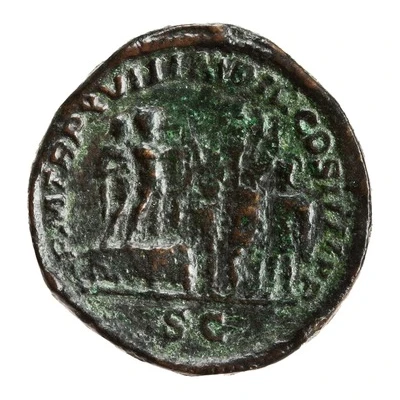


© American Numismatic Society (ANS)
Sestertius - Caracalla P M TR P XVII IMP III COS IIII P P S C
214 year| Bronze | 22.2 g | 32 mm |
| Issuer | Rome › Roman Empire (27 BC - 395 AD) |
|---|---|
| Emperor | Caracalla (Marcus Aurelius Antoninus Caracalla) (198-217) |
| Type | Standard circulation coin |
| Year | 214 |
| Value | 1 Sestertius = ¼ Denarius |
| Currency | Denarius, Reform of Augustus (27 BC – AD 215) |
| Composition | Bronze |
| Weight | 22.2 g |
| Diameter | 32 mm |
| Shape | Round (irregular) |
| Technique | Hammered |
| Demonetized | Yes |
| Updated | 2024-10-06 |
| Numista | N#273904 |
|---|---|
| Rarity index | 100% |
Reverse
Caracalla, in military attire, standing right on platform, accompanied by two officers, and haranguing officer and two soldiers, all standing left; behind, vexillum.
Script: Latin
Lettering: P M TR P XVII IMP III COS IIII P P S C
Translation:
Pontifex Maximus, Tribunicia Potestate Septima Decima, Imperator Tertium, Consul Quartum, Pater Patriae. Senatus Consultum.
High priest, holder of tribunician power for the 17th time, supreme commander (Imperator) for the third time, consul for the fourth time, father of the nation. Decree of the senate.
Comment
Mass varies: 21.96–22.39 g;Example of this type:
American Numismatic Society (ANS)
Source:
Online Coins of the Roman Empire (OCRE)
Interesting fact
One interesting fact about this coin is that it features an image of the Roman Emperor Caracalla, who ruled from 211 to 217 AD. He was known for his military campaigns and his attempts to increase the power of the Roman Empire. The coin's design, which includes an image of Caracalla and various other symbols and inscriptions, provides valuable insight into the iconography and propaganda of the Roman Empire during this time period. Additionally, the fact that it is made of bronze and weighs 22.2 grams suggests that it was a widely circulating coin that was used in everyday transactions, providing a glimpse into the economic and monetary systems of ancient Rome.